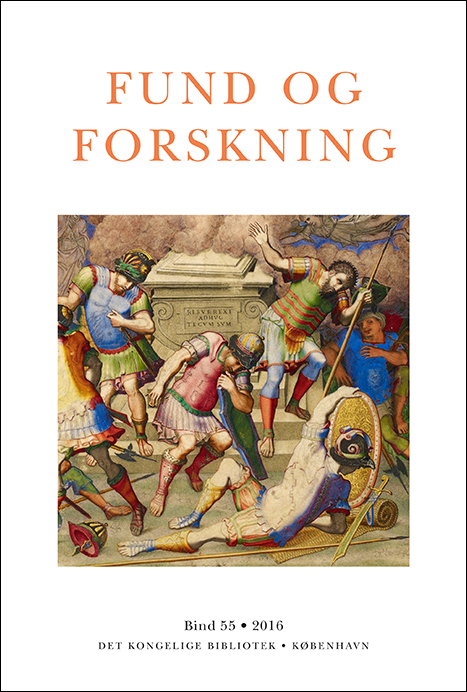Kampen om de tyske skoler i Danmark efter 1945
DOI:
https://doi.org/10.7146/fof.v55i0.118924Resumé
Kirsten Lylloff: The Struggle on the German schools in Denmark after 1945
In 1945 there were 58 private and 31 public German schools in Southern Jutland [private school and public school are defined following US-standards], all founded after the reunion of the former German region with Denmark in 1920, and one private German school in Copenhagen founded in 1575.
Since Hitler’s seizure of power in 1933 a part of the German minority in Southern Jutland openly opposed the Danish hegemony, demanding return of the region to Germany, and part of the Danish majority feared, as a consequence of Germany’s rising power, a German reacquisition of the region, especially after the German occupation of Denmark in 1940. During the occupation 9 new private German schools were build and 10 of the older buildings restored, and the budgets, which always had been partly subsidized from Germany, were raised. Germany’s payment to the schools was drawn on the German-Danish clearing account, which at the end of the war showed a huge deficit for the Danes.
With the German surrender 1945 the time was ripe for revenge for the Danish majority, and as a consequence all German schools in Southern Jutland were closed in the summer of 1945.
From January 1946 special classes for German-speaking pupils were established in some of the public schools, but it was no success, partly because of local opposition from the Danish majority, and the classes were suspended in the summer of 1946. The private German schools were allowed to reopen from January 1946, but two other post-war laws, which weren’t intended to harm the German schools, in fact closed the schools, as the laws led to the confiscation of the school buildings. The first law resulted in the confiscation of all German property in Denmark. Because mortgages in some of the school buildings were owned by German juridical persons, the Danish custodian for German property seized the mortgages and required them redeemed. The second law intended to force Danish firms, which have had an unreasonable high profit by trading with and servicing the Germans, to repay to the Danish state the excess profit. It meant that the schools were asked to repay all the payments received over the German-Danish clearing account, and as they of course weren’t able to do this, the buildings were confiscated as security.
The Danish public school only had the capacity to absorb 1⁄3 of the pupils from the German schools, and for that reason a large part of the children from the German minority couldn’t attend school until after the summer of 1946, where they were allowed entrance to the public school.
The German school in Copenhagen, Sankt Petri School, wasn’t exposed to the same national hatred towards all Germans as the schools in Southern Jutland, even though a considerable part of the pupils were German citizens. The reason was probable, that the school was “less visible” in the Copenhagen environment, than the German schools in Southern Jutland. Sankt Petri School had drawn considerable larger amounts from the German-Danish clearing account than all the German schools in Southern Jutland together, most of it used to build a new prestigious school building in Copenhagen, the rest used to salaries to the teachers.
Sankt Petri School wasn’t closed, but managed to hold on with a few pupils and by subordinating to the Danish demand, that teaching and examination were done in Danish.
At last in 1949 the social democratic government was able to push through, that Sankt Petri School’s debt to the Danish state was eliminated, and from 1959 the school was again allowed to teach and examine in German. In 1949 too, the government allowed that German private schools in Southern Jutland reacquired 13 school buildings. But pupils were not allowed to pass exams, which were meritorious to further education in Denmark, and they were under strict supervision of the local authorities, – the supervision was eventually lifted in 1952.
In 1955 the Danish Prime Minister H. C. Hansen and the German Chancellor Konrad Adenauer agreed on the Copenhagen-Bonn Declaration, concerning minority-rights on both sides of the German-Danish border. In this agreement German private schools in Southern Jutland were permitted to pass exams to their pupils, giving them right to further education in Denmark.
That was the end of the struggle, equality between German and Danish private schools was a fact. But the struggle had been expensive for the German minority. The number of pupils has never since reached the heights of the period 1920–1945.
Especially the social democrats Hartvig Frisch and H. C. Hansen were at the forefront in reestablishing the German schools, the strongest opposition coming from the political parties, Danmarks Kommunistiske Parti and Dansk Samling. Most of the Danish majority in Southern Jutland and a considerable part of the civil servants were against a reopening of the German schools, but the high ranking civil servants in the ministries followed the intentions of the various governments and did what they were told to do by their ministers, whether they were for or against reopening of German schools.


